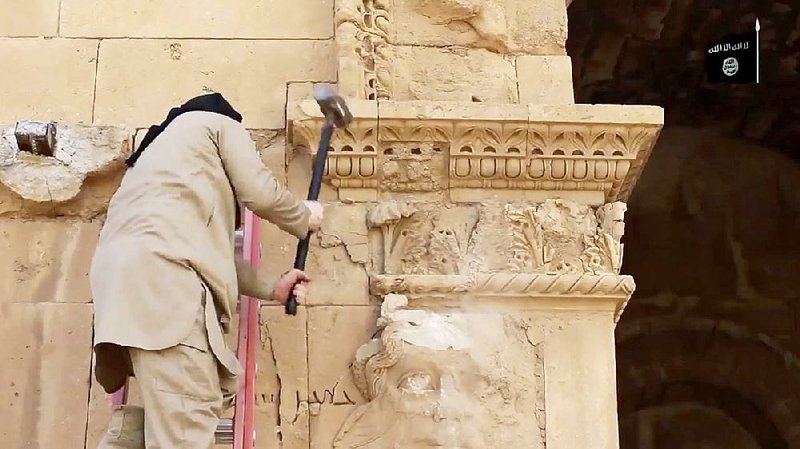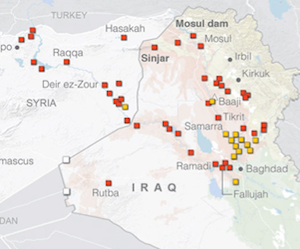BAGHDAD -- Islamic State extremists at Iraq's ancient city of Hatra destroyed the archaeological site by smashing sledgehammers into its walls and shooting Kalashnikov assault rifles at priceless statues, a new video said to be from the militant group shows.
Meanwhile in Afghanistan, a senior Shiite community leader said on Saturday the Islamic State is responsible for kidnapping dozens of Shiite men and boys in February.
Militants in Iraq attacked Hatra, a UNESCO World Heritage site, last month, officials and local residents said, though the extent of the damage remains unclear as it is in territory still controlled by the Islamic State.
The video, released overnight Friday, shows a militant on a ladder using a sledgehammer to bang repeatedly on the back of one of the carved faces until it crashes to the ground and breaks into pieces. The video also shows a militant firing a Kalashnikov rifle at another, while men chop away the bases of some of the larger wall sculptures.
The video corresponded with reporting on the attack and was posted to a website frequently used by the militant group.
One of the militants, who speaks Arabic with a distinct Gulf Arabic accent on the video, declares they destroyed the site because it is "worshipped instead of God." The Islamic State, which holds a third of Iraq and neighboring Syria in its self-declared caliphate, has been destroying ancient relics extremists say promote idolatry that violates their fundamentalist interpretation of Islamic law. Authorities also believe they've sold others on the black market to fund their movement.
Local government officials said last month the militant group had looted and destroyed several ancient sites, including the 3,000-year-old Nimrud, another UNESCO World Heritage site. United Nations Secretary-General Ban Ki-moon called the Nimrud attack "a war crime."
Hatra, located 68 miles southwest of the Islamic State-held city of Mosul, was a large, fortified city during the Parthian Empire and capital of the first Arab kingdom. The site is said to have withstood invasions by the Romans in A.D. 116 and A.D. 198 thanks to its high, thick walls reinforced by towers. The ancient trading center spanned 4 miles in circumference and was supported by more than 160 towers. At its heart is a series of temples with a grand temple at the center -- a structure supported by columns that once rose to 100 feet.
Of the kidnappings in Afghanistan, Shiite leader Mohammad Mohaqiq said two former Taliban leaders, who switched allegiance to the rival Islamic State, were responsible for the abduction of 31 members of the minority Shiite Hazara community Feb. 24 in southern Zabul province.
He spoke with The Associated Press on Saturday. It is the first time an Afghan leader has confirmed Islamic State involvement in the kidnappings.
Mohaqiq, who is a deputy to Afghanistan's Chief Executive Abdullah Abdullah, said Mullah Mansur Dadullah and Mullah Abdullah Kakar were behind the abductions. Mohaqiq said the two prominent Islamic militants had simply "changed their white flag" of the Taliban for the black Islamic State flag.
Afghan security forces had launched an operation to find the Hazaras in the week after the kidnappings, Mohaqiq said, but the effort failed.
The men have now been split up into groups of three or four and were being held in different areas of the mountainous province, Mohaqiq said. As far as he knew, they were still alive.
The Hazaras were abducted from two vehicles on a major road in Zabul province by men described by officials at the time as wearing black clothing and black masks. The armed kidnappers separated the men and boys from women, children and non-Hazaras in the vehicles.
The kidnappings sent shock waves through Hazara communities across the country and led to widespread demonstrations. On Saturday, an estimated 4,000 Hazaras marched through northern Mazar-i-Sharif, organizers said. More demonstrations are planned in Kabul in coming days.
"People across the country are worried, and they want the government to speed up its actions to resolve this," Mohaqiq said. "The government will do anything it has in hand for their release, from negotiations to fighting."
Hazara people, who account for as much as 25 percent of Afghanistan's population, are mainly Shiite. The group has been targeted by the Taliban and other Sunni extremists, who view Shiites as apostates. The predominantly ethnic Pashtun and Sunni Taliban persecuted the Hazara minority group during their 1996-2001 rule, when they imposed a harsh version of Islamic law on the country.
Information for this article was contributed by Sameer N. Yacoub, Maamoun Youssef, Lynne O'Donnell and Ahmad Seir of The Associated Press.
A Section on 04/05/2015

